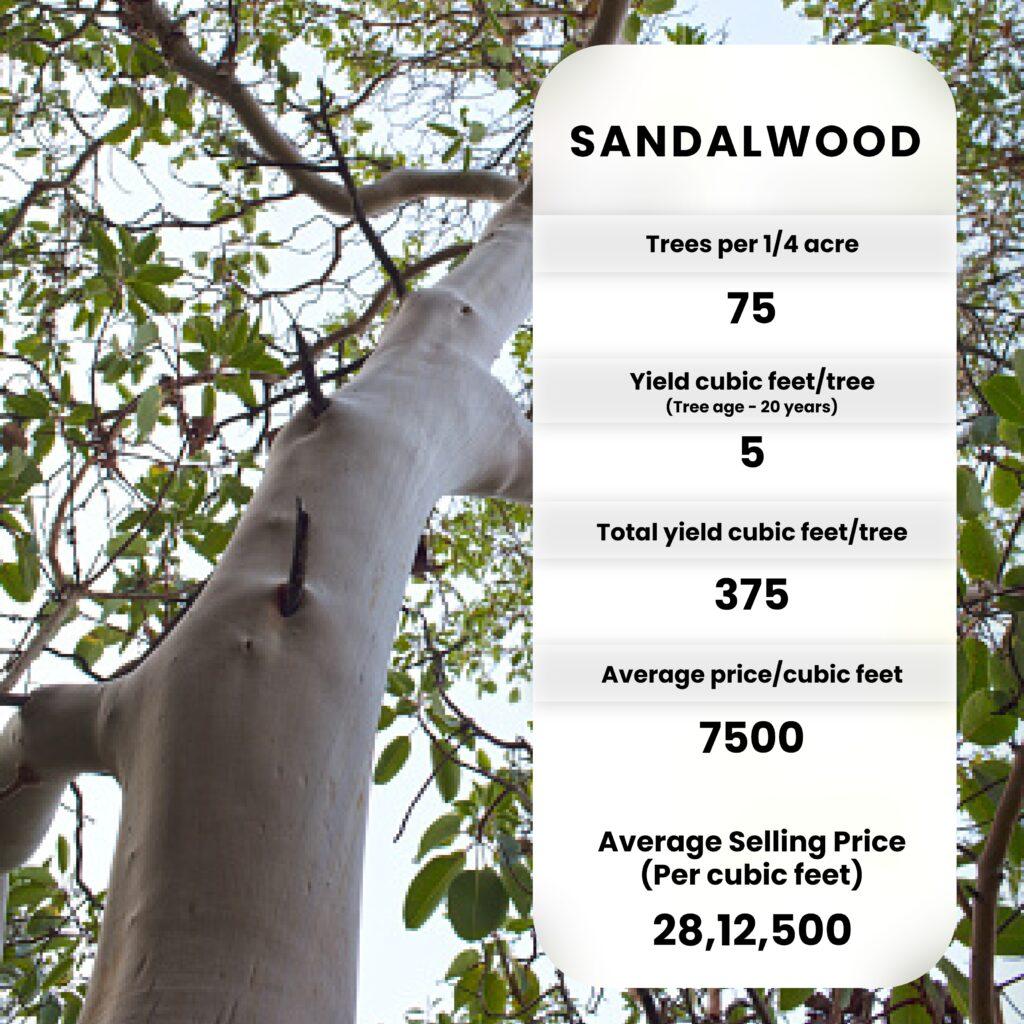About 30% of the planet’s surface is covered in forests. It also goes without saying that forests have a wealth of advantages for humanity, from reducing noise pollution to maintaining ecological balance to sustaining people and giving animals a place to live.
But did you know? 20 million acres of primary forest were destroyed worldwide between 1990 and 2020. Furthermore, it is predicted that only 10% of the world’s rainforests would exist by the year 2030. To top it all off, deforestation is the main reason for 15% of carbon emissions.
We still have a chance to undo these harms by choosing environmentally friendly practices. What if we also told you that by doing this, in addition to saving the environment, you will also gain financially rewarding advantages? Yes, you did hear correctly.
Read the complete blog to find out how planting mahogany, hebbevu, sandalwood and teak trees in your farm can earn you fantastic profits.
Mahogany: The mahogany tree is used to manufacture furniture, musical instruments, boats, hardwood floors, and other goods. Mahogany is a commercially significant material renowned for its toughness, beauty, and color. Mahogany is the most wanted wood species in this tropical area because it provides a forestry investment that is tax effective. Mahogany is the most valuable timber tree in India.
Mahogany is a giant tree that can reduce air pollution by between 47% and 69%. Its height is approximately 35–40 meters, and its thickness is approximately 125 cm.
The ability of the mahogany seed to control blood sugar is another favorable feature. In addition to all of these advantages, mahogany strengthens the immune system, lowers cholesterol levels, prevents the buildup of fat in the bloodstream, and fights free radicals.

(Note: The number of trees planted per quarter acre, the overall yield, and the average tree price are estimates based on multiple studies conducted using a variety of research methodologies. Plantations, yields, and prices may change as the environment and market change.)
Hebbevu: Hebbevu has a life cycle of roughly 12 years, making it ideal for agro farm forestry. Due to its many advantages, including its quick growth, stem’s straightness without much branching, resistance to insect attack, ability to grow in all types of soil, and even in areas with little water supply, the tree is becoming more and more well-liked among farmers.
One of the primary issues that farmers today are dealing with is declining income as a result of declining income from agricultural crops and an abrupt spike in the value of farmland.
Planting high-yielding tree species, like Hebbevu, can bring in a handsome price from the market, with a guaranteed buyback agreement and minimal maintenance costs. These trees also play a significant role in reducing the effects of climate change and sequestering carbon.
The timber can be engineered into high-end specialty goods. These premium goods not only sate consumers’ expanding appetites, but they also generate jobs. As a result, you may cultivate this timber with ease and be delighted because it grows quickly and offers significant returns on investments.

(Note: The number of trees planted per quarter acre, the overall yield, and the average tree price are estimates based on multiple studies conducted using a variety of research methodologies. Plantations, yields, and prices may change as the environment and market change.)
Sandalwood: The sandalwood tree must be the costliest wood in the world; the best sandalwood can sell for about Rs. 10,000 per kg. India and Australia both have extensive sandalwood plantations. Sandalwood trees are legally protected.
For cultivation, seedlings that are about 7-8 months old and have reached a height of 1 foot are planted. Sandalwood cultivation requires soil with a pH balance of 6.5 to 7.5. Additionally, it should be remembered that overwatering will only cause the plant to perish.
The tree will begin to grow 1 kg every year after 7-8 years of mediocre growth. By the time the tree is 15 years old, the bark will have developed. The tree will be between 13 and 16 meters in length and 1-2 meters in diameter when it is completely developed. Also, there is no usage of chemical fertilizers or pesticides in the growth of sandalwood trees.
Even the roots of sandalwood trees sell for a high price relative to their weight, therefore they are typically uprooted rather than having their branches cut off.
In addition to being cost-effective, sandalwood provides a number of health advantages, including the ability to treat a cold, issues with the liver and gallbladder, digestive issues, muscle issues, and mental difficulties. Additionally, it aids in wound healing and anxiety management.

(Note: The number of trees planted per quarter acre, the overall yield, and the average tree price are estimates based on multiple studies conducted using a variety of research methodologies. Plantations, yields, and prices may change as the environment and market change.)
Teak: One of the toughest, most beautiful deciduous woods, “teak,” is renowned for its sturdiness and resilience to various weather conditions, water, rot, and evil termites. The teak tree is a large tree with a length of between 100 and 150 feet. Teak’s bark is fibrous and either light brown or grey in color. It has grooved, quadrangular branches.
The versatility and durability of teak are its best qualities. Because of this, teak is the most popular kind of hardwood when it comes to outdoor furniture, despite being one of the hardest woods.
It is also known to be resistant to termites and the weather. Winter months are particularly bad for wood-carved furniture. The natural components of teak wood, on the other hand, completely safeguard the woodwork in all kinds of situations. Additionally, due to its high density and the natural oils found in teak, this hardwood is resistant to termites and other insects.
Teak is used in the food and medical industries in addition to furniture. Proteins, vitamins, minerals, and carbohydrates of various types can be found in teak tree leaves. Additionally, some people brew herbal teas and laxatives with teak tree blooms and leaves. It is utilized in over-the-counter medications and DIY remedies since studies show that it contains anti-inflammatory, anti-diabetic, antioxidant, anti-asthmatic, and many other qualities.

(Note: The number of trees planted per quarter acre, the overall yield, and the average tree price are estimates based on multiple studies conducted using a variety of research methodologies. Plantations, yields, and prices may change as the environment and market change.)
We sincerely hope that you would give growing forest-bearing trees in your farms some thought in light of the many health, environmental, and financial advantages.
You can reach us at +91-9513655556 or visit our website, www.moggs.in , if you need any help planting forest-bearing trees.




